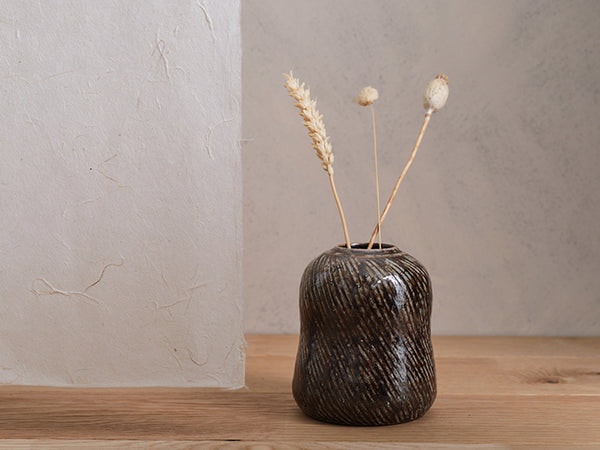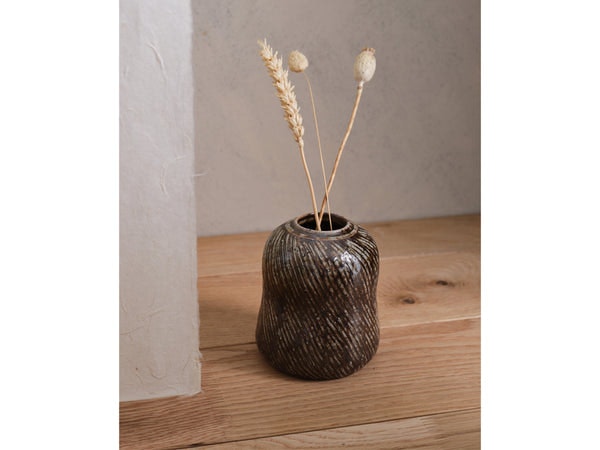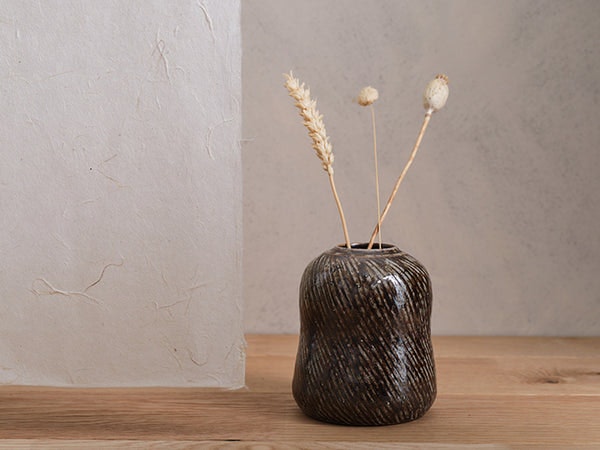Noté 4,6 sur Reviews.io
Noté 4,6 sur Reviews.io
Home / Homewares / Room Decor / Vases, Candle Holders & Ornaments / Yōhen Striped Vase By Shūji Haneishi



Politique de retour de 14 jours
Nous compensons les émissions de carbone de la livraison et de l'emballage pour chaque commande.
Support client 5 étoiles en chat en direct
 Détails du produit
Détails du produit
This vase is by Kasama based ceramicist Shūji Haneishi. The surface decoration was achieved by the movement of ash in a wood-fired kiln. These effects are known as 'yōhen.' Prior to one of his twice year wood-firings, Haneishi has combed the piece's clay using an adapted nokogiri axe, in order to influence the directional flow of the ash within the kiln. The creation of this piece involved a particularly strong use of the axe, in order to create a striped effect. The process used to make the vase means that each is inevitably unique in its decoration (and may vary from the picture shown).
It has a diameter of 10cm, and a height of 13cm. It weighs around 480g.
About Shūji Haneishi
Fitting the quintessential image of a Japanese master potter, Shūji Haneishi works with earth and fire. The possibilities of firing ceramics in wood fired kilns such as the maki-gama that Haneishi uses, have fascinated potters in Japan for centuries. Always the focus is on the right wood, the right kiln conditions, with days spent achieving them, and most important of all: the element of chance and discovery that the potter battles to create. Perfection is achieved when the energy in a form comes together with the energy in the kiln to create a compelling combination of human and nature, that is itself imperfect. In Haneishi’s case, much of his efforts are spent on controlling, or seeking to control, the kiln based movements of ash as a natural glaze. He also applies salt glaze, and other material based decorations, but all the time with the aim of eliciting new moments and reactions within the kiln. Haneishi’s interest in ceramics began in his teens, and after training in Kyoto, he established himself in Kasama in the late 1980s. From the 1990s onwards he began to appear in the prize categories in major ceramic awards in Japan, and has continued to do so since. He makes vessels for sake, or simple objects, which are always beautiful, and always connect their owners, and his branch of ceramics, to its heritage in natural effects
 Expédition et retours
Expédition et retours
Malheureusement, cet article est en rupture de stock.
Retours sous 14 jours
Pour les articles éligibles, vous avez 14 jours à partir de la livraison pour soumettre une demande de retour. En savoir plus.
Commandes entre le Royaume-Uni et l'UE ?
Il n'y a pas de frais cachés ou de charges supplémentaires une fois que vous avez payé votre commande. Profitez d'un shopping transfrontalier sans souci. En savoir plus


